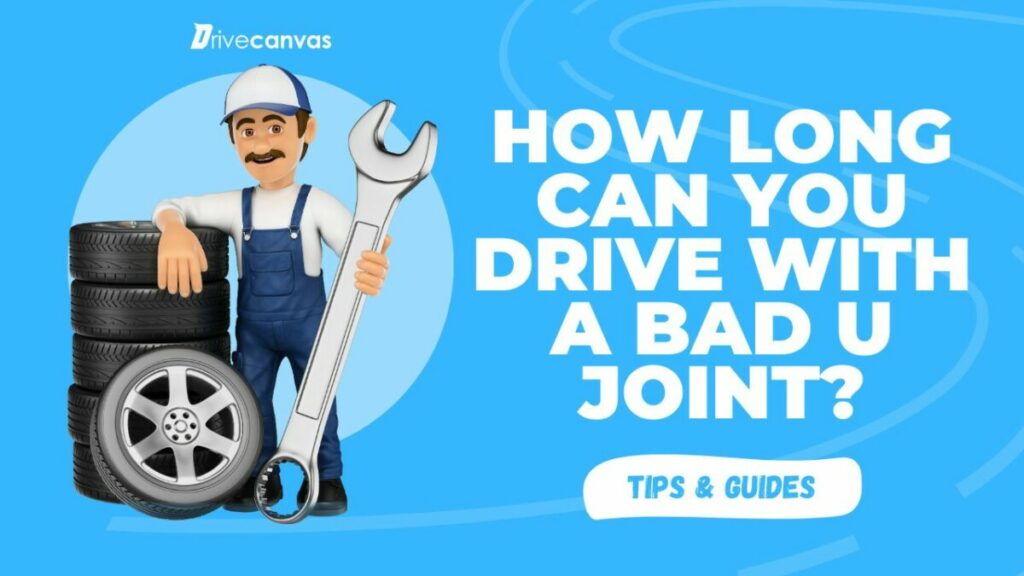Ever experienced your car shaking like it’s staging a mini earthquake? That’s not some caffeine withdrawal symptom. It could be a glitchy U-joint messing with your ride’s smoothness.
Wondering how long you can push it with this issue? Well, that’s a risky game, my friend.
This guide is here to be your savior, helping you understand the risks, recognize the red flags, and deal with the repair.
So, strap in and let’s get rolling.
Is Driving With A Bad U Joint A Terrible Idea?
I wouldn’t recommend driving with a faulty U joint. It can cause a total failure of the driveline components. It’s best to sort the U joint problem ASAP and refrain from driving the vehicle until it’s all fixed.
False
The Unpredictability of U Joint Failure

Even if you’re totally clued up on the red flags, guessing when a dodgy U-joint will finally call it quits, leaving you in the lurch, is like trying to predict the weather. The randomness of U joint failure, its causes and symptoms, can seriously mess with your head. You could pick up on some extreme shaking, a worrying thud or even a jumpy steering wheel.
But sometimes, it throws a curveball and there’s zilch in the way of warnings. The golden rule here? Prevention is better than cure. Regular check-ups and maintenance of your wheels are key. If you spot early warning signs, don’t just shrug them off.
Keep in mind, a malfunctioning U joint isn’t just messing with your ride; it could wreak havoc on other parts of your drivetrain too. So get it inspected and, if need be, swapped out. Your safety, and the long-life of your car, could hinge on it.
Effects of Worn U Joints on Vehicle Performance

When you’re cruising in your vehicle, the last thing you want is to feel like you’re driving a rickety old school bus. But that’s precisely the kind of vibe you’re gonna get if you let your U joints wear out. Trust me, it’s not a subtle thing. You’ll get this funky vibration or a weird clunking sound. It’s like your car is trying to break dance or something, and it’s a dead giveaway of a U joint on its last legs.
This isn’t just about the annoying sounds and loss of smoothness though. It can seriously mess with your control and handling when you’re out on the open road. Imagine not being able to steer properly on a highway? Not cool, right?
And if you think, ‘Well, I can live with a bit of vibration’, brace yourself. A worn-out U joint can go kaput any time, making your beloved ride a giant paperweight. Remember – your car’s all about the domino effect; one bad part can trigger a chain reaction of damage.
The Crucial Role of Regular Maintenance

Keeping your ride in top shape is a no-brainer, right? Regular maintenance is the secret sauce that helps you avoid any nasty surprises under the hood, like drivetrain damage. It’s all about making sure your car or truck sticks around for the long haul.
Now, if you’re a bit of a gearhead, you might be tempted to roll up your sleeves and get your hands dirty with some DIY magic. But, just a heads up, professional services usually offer a more complete package, with warranty and all.
Let’s dive into the pros and cons of playing home mechanic versus leaving it to the pros, all with the aim of keeping your vehicle purring like a kitten.
Maintenance Prevents Drivetrain Damage
Sure, you might be able to get by with a wonky U joint for a bit, but let’s not forget the big picture here – regular check-ups can save your drivetrain from potential damage and give your ride a longer life. It’s all about finding the sweet spot between going the DIY route and calling in the pros, based on how handy you’re and how tricky the job is.
- Keep your senses sharp for any red flags indicating a U joint on its way out, like weird sounds or vibrations when you’re on the move.
- Checking up regularly could help you spot issues before they blow up. As a rule of thumb, give your U joints a once-over every time you’re changing your oil.
- If you’re someone who’s good with their hands, why not swap out a dodgy U joint yourself? The internet is your oyster when it comes to step-by-step guides.
- When in doubt, don’t hesitate to bring in the big guns. A pro can give a top-notch evaluation and fix-up.
DIY Vs Professional Repairs
When you’re grappling with a dodgy U joint, you’ve got two options on the table – roll up your sleeves and dive into some DIY, or get a pro on the job. This decision isn’t just about the current fix though, it can also affect how your ride holds up in the long run.
Now, if you’re the kind of person who’s handy with a wrench, the DIY route might seem pretty tempting. But, here’s the thing, you’ve got to be sure you’ve got the right gear and enough know-how to prevent making things worse. It’s a bit like playing surgeon, but with your car instead of a human body.
Enter the pros. These folks have the skills, training, and experience to get things done right, no mess, no fuss. It’s like they’ve got a sixth sense for car troubles, and they can sort out your U joint issues without breaking a sweat.
When it comes to costs, it’s easy to think DIY is the cheaper way to go. But, consider this – if you mess up the repair, you could be shelling out a lot more in the long run. It’s like buying a cheap pair of shoes that fall apart after a few weeks, only much more expensive. Regular visits to a professional might seem like a dent in your wallet now, but they could save you from a major cash hemorrhage down the line.
The Process of U Joint Repair and Replacement

When it comes to fixing or swapping out a U joint, you’re faced with a couple of main routes to take: roll up your sleeves and get your hands dirty with a bit of DIY, or play it safe by enlisting the services of a pro.
If you’ve got a knack for anything technical, own a solid toolbox, and you’re feeling pretty pumped about it, you might just have what it takes to tackle the U joint replacement on your own terms.
But let’s be real, getting a professional on board is often the smartest move, particularly if car maintenance isn’t exactly your strong suit or something you’re well-versed in.
DIY U-Joint Replacement
Alright, ready to tackle a U-joint replacement at your crib? As long as you’ve got the right DIY tools and a bit of know-how about cars, you’re good to go. Let’s break it down:
- Spot the U Joint Symptoms:
Ever noticed any weird squeaking or shaking when you’re out and about in your car? That could be your U joint crying out for help. If it keeps up, it’s time to give it a look.
- Kick Out the Old U Joint:
First things first, get your car safely up on jack stands. Then, it’s time to get dirty and pull out the driveshaft. Whip out your press and say goodbye to that old U joint.
- Welcome the New U Joint:
Now, get your hands on your shiny new U joint. Line it up just right and use your trusty press to secure it in its new home in the driveshaft.
- Put the Driveshaft Back in Its Place:
Last step – get that driveshaft back where it belongs. If you’ve done everything right, those annoying noises and shakes should be a thing of the past. Enjoy the smooth journey ahead!
Professional Repair Options
So you gave DIY a shot, and it just wasn’t your jam? No worries, there’s a boatload of pros out there who can sort out your U joint repair or replacement.
Here’s the deal: First off, they’ll give your ride a once-over, checking for any red flags that your U joint might be on the fritz. We’re talking weird sounds or your car shaking more than it should.
After that, they’ll take out the messed up U joint. This involves parting ways with the drive shaft, but trust me, it’s necessary. Then, they’ll pop in the new U joint and make sure it’s locked in nice and tight.
As for the dent in your wallet, it can vary. You’re usually looking at something between $150 and $350. But hey, that includes the cost of the parts and the elbow grease to put it all together. And honestly, it’s a solid investment to keep your car purring like a kitten. Safety and efficiency? Totally worth it.
Exploring the DIY Approach to U Joint Change

You might be toying with the idea of taking a hands-on approach to swapping out your U joint. Now, that’s a solid plan, but it’s super important to be armed with the right set of tools and a solid understanding of what you’re doing to ensure the job gets done right, without any hiccups.
Let’s take a quick glimpse at the upsides and downsides of getting your hands dirty with a DIY U joint replacement, and I’ll throw in some nifty tips to help you nail it right at your garage:
- Upsides: You get to pocket the cash you’d otherwise spend on labor, plus you’re in for a cool chance to up your mechanical skills.
- Downsides: This isn’t a walk in the park, you need the right tools, a fair bit of mechanical know-how, and let’s not forget, it can be a bit of a time-sink.
- Hot Tip 1: When you’re taking out the old U joint, always opt for a joint press. Give the hammer a rest; it’s not gonna do you any favors here.
- Hot Tip 2: Show your new U joint some love by greasing it up before you install it. It’s a small step, but it’ll help it live a longer life.
Safety always comes first, so if you’re feeling a tad uncertain, it’s totally okay to call in a pro. Remember, there’s no shame in asking for help.
Wrap Up: Bad U Joint’s Impact on Your Driving Experience and Risks Involved

Let’s take a minute to acknowledge how beasts like Toyotas, Ford Focuses, or any other brand can perform when treated right. They can last a good, long while and its value over time might surprise you. But let’s draw attention back to your U joint scenarios, because the big question isn’t just about enduring a bad U joint—it’s also about learning the ropes and steps to maintain your ride properly.
We all gravitate towards the question, “How many miles can a Ford Focus last?“. It’s a good question, right? The same principle applies to U joints. Don’t let any joint issues drag the life out of your car. Take the initiative and be proactive when it comes to identifying and sorting the problems in your ride, even before they turn serious.
Another burning question that you’d find popping up in forums is our next contender, “Do Toyotas hold their value?“. Again, a valid concern, mate. Just as how you’d be concerned about how long you can tolerate that bad U joint. Whatever you’re driving, remember the worth of these beasts matter in the long run, be it a Toyota or a Ford Focus.
Mind you, maintenance isn’t just about the torque and bolts. For instance, did you ever find yourself wondering “When is it too cold to wash your car?” Or how this might affect the overall performance or longevity of your vehicle? Think about it, will the paint peel, will the water freeze? Well, might wanna check that link out. All this to say, the tiniest details matter, even if it’s something as trivial as washing your car in the winter.
So, while you’re figuring out how much more mileage you can muster with a grumpy U joint, keep these aspects in mind. Happy driving!

